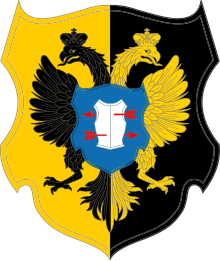Kirill Razumovsky
This article has multiple issues. Please help improve it or discuss these issues on the talk page. (Learn how and when to remove these template messages)
|
Kirill Razumovsky | |
|---|---|
 Portrait of by Louis Tocqué, 1758 | |
| Hetman of the Zaporizhian Host | |
| In office 1750–1764 | |
| Monarchs | Elizabeth Peter III Catherine the Great |
| Preceded by | Office re-established (previously Danylo Apostol) |
| Succeeded by | Office abolished |
| Personal details | |
| Born | 18 March 1728 Lemeshi, Kiev Regiment, Cossack Hetmanate, Russian Empire |
| Died | 9 January 1803 (aged 74) Baturin, Chernigov Governorate, Russian Empire |
| Resting place | Refectory Church of Resurrection of Christ,[1] Baturyn |
| Spouse | Yekaterina Naryshkina |
| Children | 11, including Aleksey, Andrey, Grigory and Natalia |
| Residence(s) | Saint Petersburg Baturin |
| Military service | |
| Allegiance | |
| Rank | Field Marshal (1764) |
Count Kirill Grigoryevich Razumovsky or Razumovski (also known as Cyril Razumovski; Russian: Кирилл Григорьевич Разумовский; Ukrainian: Кирило Григорович Розумовський, romanized: Kyrylo Hryhorovych Rozumovskyi;[2] 29 March [O.S. 18 March] 1728 – 21 January [O.S. 9 January] 1803) was a Russian statesman of Ukrainian Cossack origin who served as the last hetman of the Zaporozhian Host on both sides of the Dnieper (from 1750 to 1764) and then as a field marshal in the Imperial Russian Army. Razumovsky was also the president of the St. Petersburg Imperial Academy of Sciences from 1746 to 1798.
Biography[edit]

Kirill Rozum was born into the family of the low-rank Cossack Grigory (Hryhoriy) Rozum in the settlement of Lemeshi in the Kiev Regiment (now in Chernihiv Raion, Chernihiv Oblast, Ukraine) on 18 March 1728.[1]
From 1743 to 1744, Kirill Razumovsky incognito attended the University of Göttingen. Razumovsky's adjutant in his journey to Germany was Grigory Teplov. Teplov wielded influence over Little Russia in his capacity as the secretary and advisor to Kirill Razumovsky (whose cousin he married). Razumovsky was appointed President of the Russian Academy of Sciences when he just turned 18 years old due to the influence of his brother, Aleksey Razumovsky, the morganatic husband of Empress Elisabeth of Russia.
In 1750, Razumovsky was elected and subsequently appointed Hetman of Zaporizhian Host, a title he held until Catherine II of Russia abolished this title in 1764, in exchange Razumovsky was granted a rank of Field marshal of Russian Army in 1764. During his service as Hetman of Zaporizhian Host, Baturin was re-established as residence of the Hetman, and Razumovsky had opulent baroque palaces erected both in Baturin as well as in Glukhov by the imperial architect Andrey Kvasov and Charles Cameron. Together with Grigory Teplov he also planned to open a university in Baturin. Kirill Razumovsky died in January 1803 in Baturin, where he was interred according to his wishes without any pomp, in stark contrast to his rather flamboyant lifestyle.
Kirill married Yekaterina Naryshkina and had five sons, of whom Count Aleksey Kirillovich Razumovsky (1748–1822) was the Minister of Education in 1810–1816, and Prince Andrey Razumovsky (1752–1836) was the Russian plenipotentiary ambassador in Vienna in the years of the Congress 1814–1815. However, Andrey has become better known for his role as patron of Ludwig van Beethoven who dedicated three String Quartets, Op.59 1, 2 and 3, as well as the 5th and 6th Symphonies to him. Any living descendants in the male line of Kirill Razumovsky arise from the progeniture of his fourth son Gregory Razumovsky (1759–1837), who had to emigrate to Western Europe and acquired relative fame as natural scientist and member of a number of distinguished scientific societies in Austria, Prussia and Switzerland.
Coat of arms[edit]
 |
Legacy[edit]
- In 2009, on the Day of Unity of Ukraine, a monument titled Prayer for Ukraine was unveiled in Baturyn. In it are represented five hetmans: Demian Ihnatovych, Ivan Samoilovych, Ivan Mazepa, Pylyp Orlyk and Kirill Razumovsky.
- In 2010 the Moscow State University of Technology and Administration was named in honour of Razumovsky.
References[edit]
- ^ a b Putro, O. Kyrylo Rozumovsky (РОЗУМОВСЬКИЙ КИРИЛО ГРИГОРОВИЧ). Encyclopedia of History of Ukraine.
- ^ Oleksander Ohloblyn. Rozumovsky, Kyrylo. Encyclopedia of Ukraine
Bibliography[edit]
- This article includes content derived from the Russian Biographical Dictionary, 1896–1918.
Further reading[edit]
- Maria Razumovsky. Die Rasumovskys: eine Familie am Zarenhof. Köln 1998. — 300 S.
External links[edit]
- Kyrylo Rozumovsky at the Encyclopedia of Ukraine
- Kyrylo Rozumovsky at the Jurist Encyclopedia
- Palace's secrets. Kirill Razumovskiy, the Last Hetman. Kultura TV Channel (Russia).
- Koliada, I; Milko, V. Kyrylo Rozumovsky. "Folio".
- Kyrylo Rozumovsky. Ukrainians in the World.
- Soroka, Yu. Hetmanless period and the last Hetman of Ukraine.
| Predecessor Governing Council (Yakiv Lyzohub) |  | Hetman of Zaporizhian Host 1750–1764 |  | Successor Collegium of Little Russia (post liquidated) |


 French
French Deutsch
Deutsch